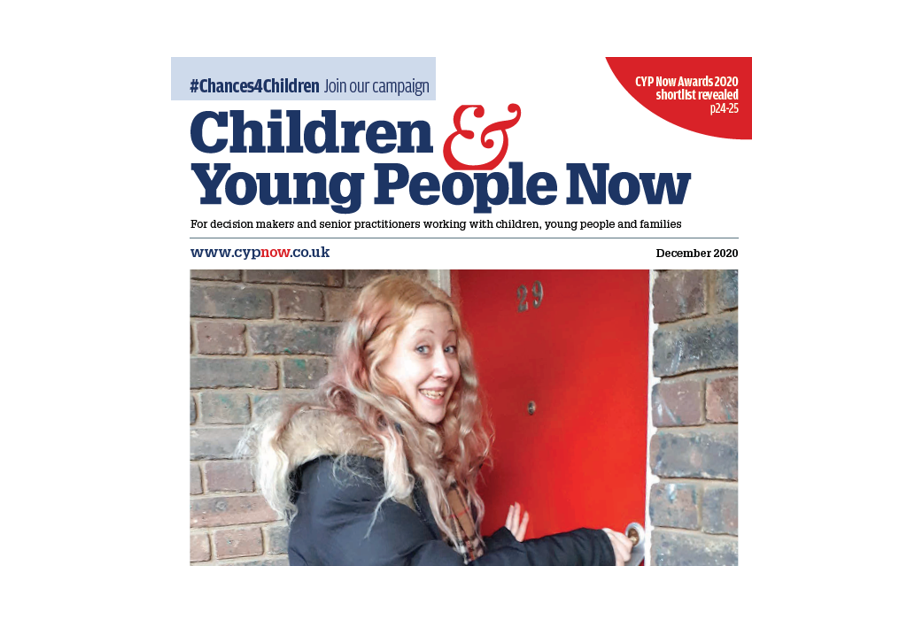CYPNow Feature Article - Making a house into a home
Posted 2nd December 2020
The National House Project works with councils to support young people in care to move into their own homes. Jo Stephenson spoke to staff and participants to find out how it works and the difference it makes.
While in care, Tia experienced multiple placements and moved around a lot. So when offered the chance to take part in a project that would help her get her own place, she was excited.
“Initially everyone’s first thought is ‘Wow – I’m going to get a flat’,” she says. But it was so much more than that, she explains.
Tia was among the first to take part in Islington’s House Project – one of the local schemes set up under The National House Project, which aims to support young people in care to move into their own homes and live successful, independent lives.
The 20-year-old admits moving into her own place did feel “quite overwhelming”. However, the House Project taught her “all the stuff I need to know living by myself”.
It’s not just the practical support that made the difference but the friendships she made, the opportunities it opened up and the skills and confidence she gained. “It has made a big difference in my life personally,” says Tia.
Every year in England around 10,000 young people like Tia face the daunting prospect of leaving care – moving to independence without the support of close family and at a much earlier age than the general population.
The experience has been likened to being “dropped off a cliff”. Research suggests about a third of care leavers experience homelessness within the first two years after leaving care. They are more likely to experience mental health problems while more than a quarter of adult prisoners were once in care.
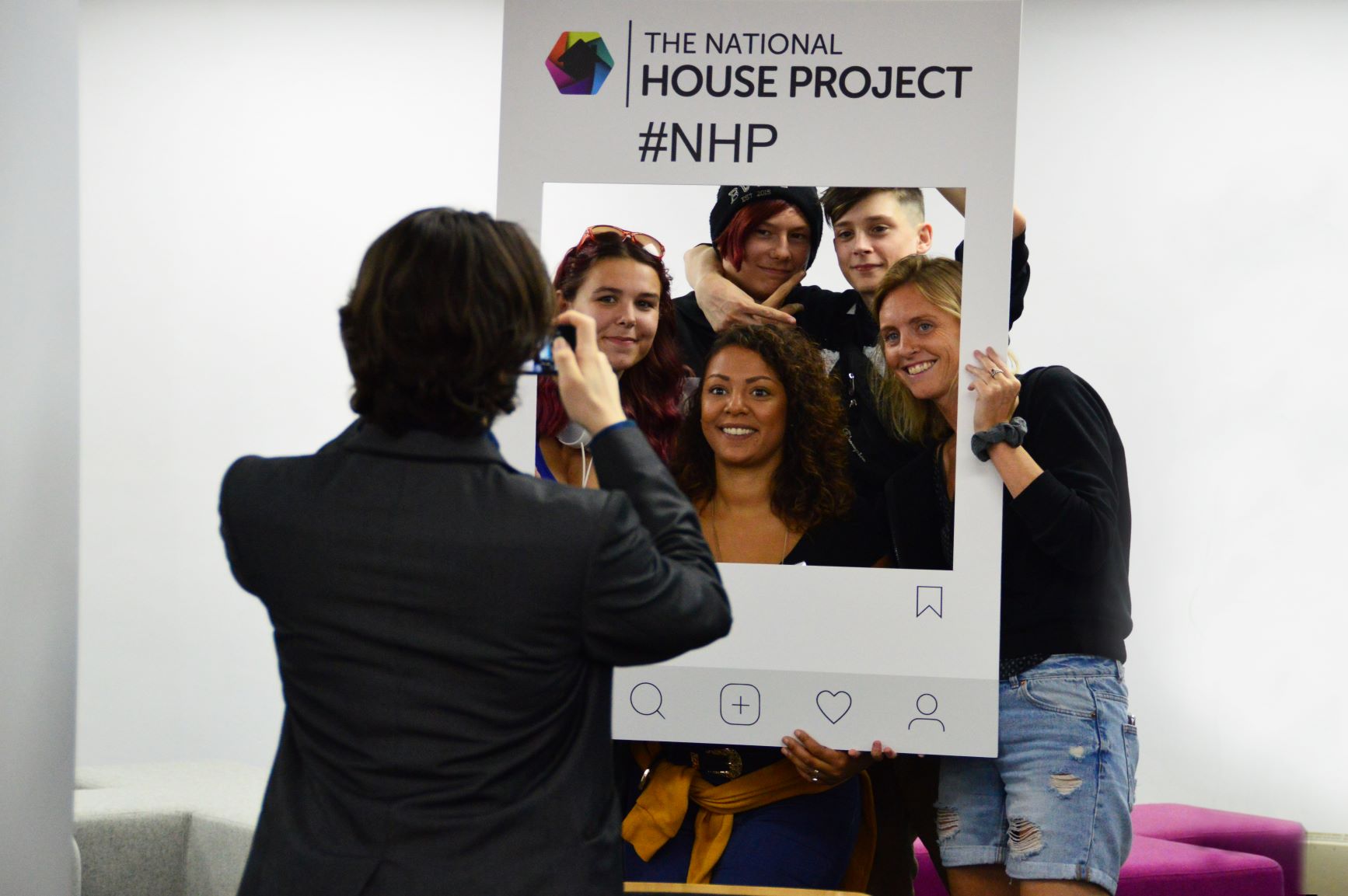
The first House Project – established in Stoke-on-Trent in 2015 – was spurred by recognition that what local authorities were doing “was not good enough”, explains National House Project chief executive Mark Warr, a former assistant director of children services.
A tendency to focus on managing risk and vulnerability means looked-after young people can lead quite sheltered lives up to the point they move on, he explains.
“We wanted to put young people at the centre of decision-making – giving them a choice of where to live and a house that is theirs for as long as they want, creating that stable home environment from which they could then be successful in the adult world,” he says.
Young people – who can join the project aged 16 with most moving into properties aged 17 – work through a programme of accredited modules designed to support all aspects of their personal development. This includes learning practical skills like cooking and budgeting as well as planning and organising events, pitching ideas and creative and team-building activities.
Participants complete the programme in groups, learning together and supporting each other – one of the positives highlighted in an evaluation by the University of York. “We’ve found the group work approach to leaving care to be a unifying and energising process for young people,” says Warr. It makes leaving care “less scary” and creates a support network. “We call it a community of peers – they call it mates,” he says.
Crucially, the project is underpinned by a psychological framework based on an understanding of attachment and the impact of trauma and “self-determination theory” – the idea that to thrive everyone needs to feel competent, in control and a sense of belonging.
The pilot in Stoke – funded by children’s social care innovation funding from the Department for Education – led to further funding from the DfE to test the approach in five other authorities – Islington, Oxfordshire, Warwickshire, Rotherham and Doncaster – and set up a national hub to roll it out.
The national project – which became a charity in 2018 – supports councils to set up local schemes.
There are currently 11 local House Projects in different parts of the UK with Wolverhampton and Manchester added to the list in England. Meanwhile, the National House Project is working with the Life Changes Trust to establish projects in Scotland.
This does feel like a new way of working, says Ellie Lewis, project lead for Islington’s House Project. “Often youth participation projects go so far but there is not actually that much power or decision-making clout given to young people,” she says. “This project is more of a genuine partnership.”
Tangible change
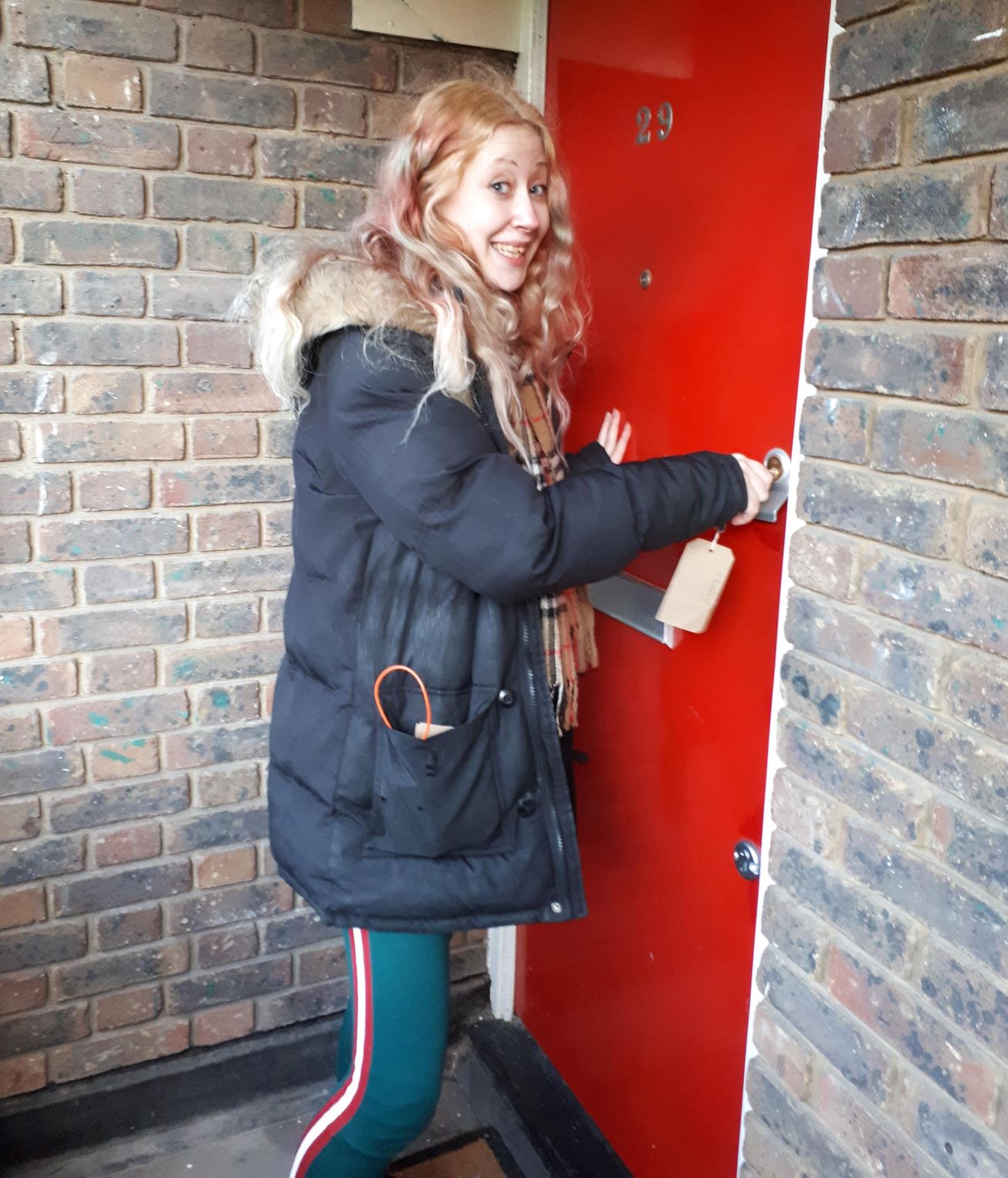 Islington is currently settling in their second cohort of House Project participants and recruiting a third. Of the first cohort of 10, seven have been housed with an eighth due to be housed imminently. Meanwhile 10 out of the second cohort of 12 have been housed.
Islington is currently settling in their second cohort of House Project participants and recruiting a third. Of the first cohort of 10, seven have been housed with an eighth due to be housed imminently. Meanwhile 10 out of the second cohort of 12 have been housed.
That fact young people are treated as “equal decision-makers” and see tangible change resulting from their feedback and ideas, is hugely important, says Lewis.
For example, they asked for flats to be painted white instead of magnolia and for fridges, cookers and washing machines to be installed before they moved in.
The pressures on housing supply in London have been a challenge. In Islington young people are being housed in council flats and there were some initial delays in accessing properties due to a range of factors including a major re-structure of the housing department.
Another challenge for House Project staff has been assessing whether young people are truly ready to take on the responsibility of a tenancy. “You’re weighing up lots of different factors and potential risks and – sometimes – differences in professional opinion,” she says.
Her team’s confidence has grown as they have seen young people like Tia move into their own flats and flourish with decisions made in close consultation with the council’s leaving care team.
Covid-19 has presented a new array of challenges. “We’ve had to do a lot of the sessions online which does feel less fun,” says Lewis. “It has been a challenge keeping that momentum going and trying to build relationships with young people virtually.”
Islington is exploring the idea of expanding the scheme to two cohorts a year. Meanwhile, the authority will be working with young people like Tia to co-develop an intensive pre-tenancy training course for those in care getting flats through the usual system.
Two young people from each local project represent their peers on the Care Leavers National Movement (CLNM) with two members of that body acting as advisers to the National House Project board of trustees.
The CLNM, which meets every six weeks, is facilitated by young person’s participation and development worker Rosie Blackett, who herself grew up in care.
The group provides an opportunity to develop ideas, share success stories from local House Projects and discuss challenges. Members are currently being trained as peer evaluators so they can go and assess how well local House Project schemes are working in different parts of the country.
While it was originally set up to inform and influence the work of the National House Project, the CLNM quickly took on a wider remit with young participants keen to address wider issues within the care system, explains Blackett.
Covid shone a spotlight on the importance of digital connectivity and the CLNM played a pivotal role in a recent campaign calling on the government to ensure care leavers can access the internet.
The group is also looking at fuel poverty and how difficult it can be for young people to get the best energy deals. Their ultimate ambition is to find a local authority to pilot a best practice care leaver offer they have developed as part of efforts to ensure a standardised, minimum offer for all.
Before Blackett joined the National House Project team she was a police officer specialising in child exploitation and gangs.
“I was lucky and had a really good experience of being in care,” she says. But she knows many others are not so fortunate. She can see first-hand how the House Project and involvement in the CLNM empowers young people. “To see them articulating why certain things are important and fight their corner is incredible,” she says.
The National House Project has worked with the charity Changing Minds UK to ensure a “trauma-informed” approach and provide training to staff.
Charlene Rouski, senior clinical psychologist at Changing Minds, who leads on the charity’s work with the programme, believes this is crucial to the scheme’s success.
“Young people who have experienced significant trauma, neglect, attachment disruption and adverse childhood experiences are likely to present with some complex, high-risk behaviours and that can create anxiety within the system and the people supporting them,” she says. “If this anxiety is not managed well and these difficulties not understood then it can lead to an array of further challenges.”
An ill-informed or inconsistent response risks creating difficult relationships between young people and staff and at worst can “re-traumatise” children in care and those seeking to help them.
As part of the training, staff learn the importance of “psychological formulation” – really understanding a young person’s story and how their experiences may shape their behaviour.
Under the programme, local projects must have monthly input from psychologists to help them apply these principles – and deal with specific situations when they arise.
This is incredibly helpful says Matt Smith, team leader for the House Project in Warwickshire. He also welcomes the fact House Projects around the country link up to share ideas, problems and solutions.
County-wide expansion
At the moment Warwickshire’s scheme only operates in the north of the county but there are plans to expand county-wide following two successful cohorts.
All eight young people who took part in the first cohort have been housed while seven out of 11 in cohort two have moved into new homes.
In Warwickshire young people would normally meet once a week to do an activity or some learning together. Staff also meet each participant one-to-one at least once a week or more often if needed. The fact they are able to spend so much time with young people and forge strong relationships is key especially when it comes to dealing with problems, says Smith.
“We have had a few situations where housing have got in touch saying there has been a complaint from the neighbours,” he says. These have mainly revolved around parties and drinking but staff have worked with young people to sort things out.
“It is a fantastic model and gives young people a sense of pride and something to work towards,” says Smith. But it is not right for every young person.
“Some want to stay put in their current foster care placement, some couldn’t work in this way and some just aren’t ready for this kind of independence,” he says.
Sourcing enough properties has been a challenge for the two-tier authority. Some have been supplied by Nuneaton and Bedworth Borough Council while the rest have come from private landlords. The authority is also speaking to housing developers interested in buying properties specifically for the scheme.
“It has taken a lot of energy and effort to get housing on board but we are finally getting there,” says Smith.
Running a House Project costs between £170,000 to £230,000 per year and on top of that local authorities must cover the costs of a young person’s rent and bills until they turn 18.
However, councils can save hundreds of thousands of pounds each year by moving young people from expensive placements into their own homes (see graphic).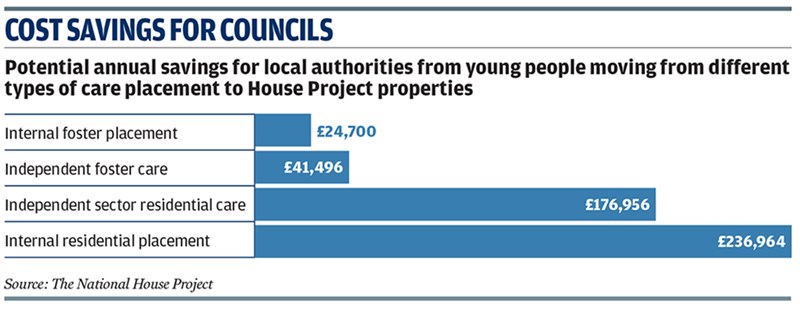
Annual savings have to date ranged from £150,000 to upwards of £400,000. This doesn’t take into account long-term savings from preventing homelessness, ill-health and young people entering the criminal justice system.
Going forward the plan is to expand to at least 30 House Projects over the next four years by charging a membership fee to local authorities. The project was awarded £635,000 in 2020/21 by the DfE to support it to achieve that goal.
The national project was also awarded £350,000 by the DfE to help local authorities develop websites for care leavers to provide all the information they need in one place, share positive stories and communicate.
Tia, who has been in her flat for about a year, is currently looking for a job or an apprenticeship. She was heading for a career in construction but is now considering youth work inspired by her experiences with the House Project.
She would like to see every local authority run a House Project. “Everyone deserves an opportunity like this,” she concludes.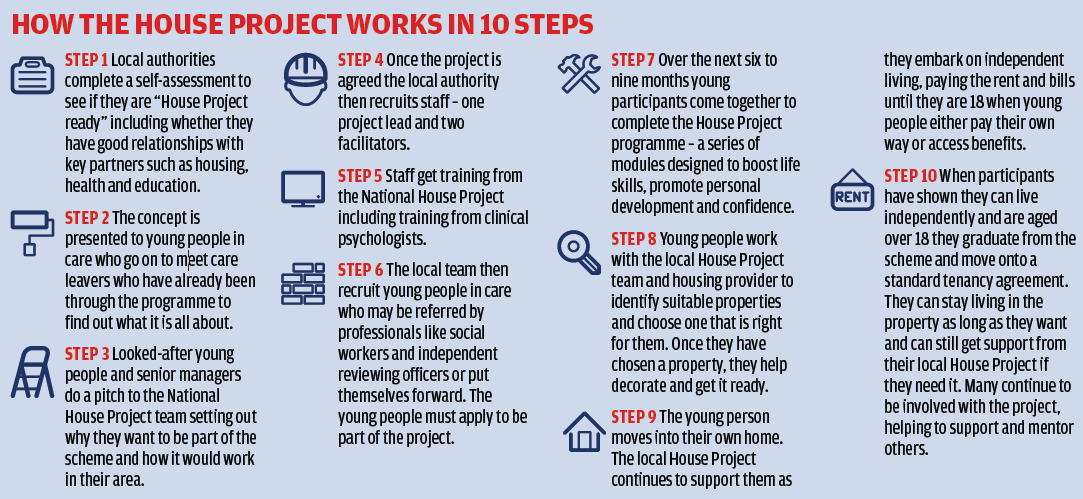
IT HELPED ME TAKE THAT SCARY NEXT STEP
Marshall, aged 18, has been living in his flat for about a year and is about to move onto a council tenancy. “To move off the project and into an actual tenancy feels like a big step – it’s like getting my foot out into the world,” he says.
“To move off the project and into an actual tenancy feels like a big step – it’s like getting my foot out into the world,” he says.
He was among the second cohort of young people to take part in the House Project in Stoke-on-Trent.
He found out about the scheme from his social worker and was particularly interested in the opportunity to gain key life skills like cooking.
“The idea there was a project to do that on then move into my own property just seemed really appealing,” he says.
He looked forward to going to sessions each week and appreciated the fact he was with other young people in care.
“Being in care, I felt quite distanced from my other friends, I felt quite different,” he says. “But this was an environment where everyone had something to relate to.”
The most useful part of the programme for him was “most definitely the budgeting”. “My biggest fear was managing my finances – what I would have to be paying and what money was going where,” he explains.
He looked at a couple of properties before choosing the two-bedroom flat where he lives now, helping with decorating and repairs before moving in.
It was not all plain sailing as after moving in Marshall lost his apprenticeship in IT. However, he says the House Project team “immediately helped me out” with accessing financial support and then finding a new apprenticeship.
He was one of Stoke’s representatives on the Care Leavers National Movement (CLNM) and is now one of five founders who support the group. He feels the project has “done wonders for the image of children in care” and boosted his skills and confidence.
“It allowed me to come out of my shell and be a lot more comfortable in my identity,” he says.
Marshall feels he owes the project a lot and wonders where he might be now if he hadn’t taken part. “I imagine I wouldn’t be in a good place right now,” he says. “I would struggle to find anywhere to take me and fear I’d end up on the street or possibly back with a parent. It was good there was something to help me with a really scary next step I wasn’t sure I’d be able to do.”
He feels positive about the future and is determined to “knuckle down” and complete his apprenticeship. “I feel great,” he says. “I still think it’s really strange when I step inside my house to think it is my home – but I am happy.”
PROJECT HELPS BUILD POSITIVE RELATIONSHIPS
By Jo Dixon, co-director, Child Welfare Research Group, University of York
Researchers from the University of York evaluated the first House Project in Stoke-on-Trent in 2016 and found that it gave young people more control over their move from care to independent living and provided improved support. Evaluation of the second phase of the pilot, which saw an expansion into five local authorities and a transfer of management to the National House Project charity, took place from 2018 to 2020.
WHAT WE LOOKED AT
The evaluation focused on how the House Project was working in practice across the five local authorities and how it contributed to outcomes for young people. The research included interviews and surveys with 37 professionals including House Project and local authority staff, National House Project consultants and housing providers. We also conducted focus groups, interviews and surveys with young people and their House Project and leaving care workers and explored information on housing, education, training and employment and wellbeing for all young people who embarked on the scheme. Finally, a cost-benefit analysis was carried out by York Consulting. Information was gathered for 40 young people as they started out on the project. They were then followed up on average 13 months later. This included interviews with 33 young people conducted by other care leavers trained as peer researchers by the university.
WHAT WE FOUND
The House Project was working successfully and had secured commitment to continue in all evaluation sites. Cost analysis suggested it had potential to generate a positive return on investment and there were early indications it was contributing to positive progress for young people.
Young people’s confidence, wellbeing and decision-making had improved over time, highlighting the beneficial effects of the project’s intensive, psychologically informed and individualised support and the group work approach. A key benefit of the House Project was supporting young people to build positive relationships and form a peer community, described as their “House Project family”, to help each other navigate the journey from care together and reduce the risk of isolation and loneliness.
Just over half – 53 per cent – had moved to their House Project home by follow-up, limiting evaluation of post-move outcomes. However, all were settling in well. There was little unexpected movement and no evidence of evictions or homelessness, suggesting stability in the early months after leaving care. Participation in education, employment and training had decreased when participants were followed-up, indicating a need for greater focus on this area.
IMPLICATIONS FOR PRACTICE
Early challenges, such as protracted contracting processes and timescales for securing properties and enlisting psychological input at local level, highlighted gaps in general provision like housing and mental health services. Some of these obstacles were mitigated by requiring key stakeholders such as housing, health and education to be on board at project set-up to ensure commitment, agreed expectations and sufficient and timely referrals and properties. Contingency planning with carers and leaving care services was crucial to ensure young people could remain in their placement longer if their house allocation was delayed, young people were not ready to move or leaving care plans altered.
Independent management, via the national charity, brought added value including the freedom to adapt the scheme and generate the momentum and credibility to scale-up the project. Keeping young people at the centre of House Project work and decisions about their own journeys was instrumental in developing their skills and engagement with the project and demonstrated the power of co-production. Most – 90 per cent – of young people were aged 18 or under at follow-up and in the early stages of their leaving care journeys. Longer-term monitoring, particularly after young people graduate from the programme, will be important for tracking participants’ long-term outcomes and experiences.
The research was carried out by Jo Dixon, Jade Ward, Caroline Cresswell with Zainab Maqbool & Amy Mook
Click here to access the report


